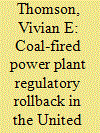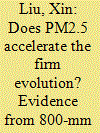|
|
|
Sort Order |
|
|
|
Items / Page
|
|
|
|
|
|
|
| Srl | Item |
| 1 |
ID:
162330


|
|
|
|
|
| Summary/Abstract |
President Trump wants to promote coal and weaken Clean Air Act regulations that affect coal-fired power plants. We analyze which US regions have benefited from air quality improvements realized since adoption of two Clean Air Act power plant rules, the transport and mercury rules, which have been targeted by lobbyists and national officials. For 20 coal states, we create a pre-regulatory emissions scenario for the current (2016) fleet of power plants. Using the US Environmental Protection Agency's CO-Benefits Risk Assessment screening model, we estimate the differences between the impacts of pre-regulatory emissions and current emissions on fine particulate matter (PM2.5) concentrations and on public health. We compare those impacts with voting patterns in the 2016 presidential election and with demographic data. Among the air quality and public health gains of the current situation relative to the pre-regulatory scenario are that: annual average PM2.5 concentrations are lower by 1–5 μg/m3; 17,176–39,291 premature mortalities are avoided for each year of lower emissions; coal mining counties and White, rural counties experience some of the best improvements in air quality; and, in several states, Trump counties benefit more than Clinton counties. We suggest refining these results with atmospheric dispersion models.
|
|
|
|
|
|
|
|
|
|
|
|
|
|
|
|
| 2 |
ID:
177364


|
|
|
|
|
| Summary/Abstract |
Carbon policies differentiated according to regional disparities have been recognized and recommended. However, the air quality co-benefits of differentiated policies remain unclear. Here we combine a multi-regional dynamic computable general equilibrium (CGE) model and an extend response surface model (ERSM) to investigate the impact of nationally uniform and subnationally differentiated carbon pricing policies on fine particulate matter (PM2.5) concentrations in China. All policies examined lead to the same accumulated national CO2 emissions (2020–2050), with the 2030 emissions attaining China's national abatement target. We find that, when subnational policies differentiated according to provincial PM2.5 concentrations are implemented, the higher-than-average carbon price over more polluted provinces results in twice as much reduction in CO2 and air pollutant emissions in 2050 as the national policy. As a result, the subnational policies cause larger PM2.5 concentration reductions in these provinces (9%–18%) than the national policy (7%–11%). Also, the subnational policies eliminate high PM2.5 exposure of over 45 μg/m3 which 12% people suffer from under the national policy. The subnational policies substantially reduce regional disparity in PM2.5 pollution and hence improve environmental equity. The results suggest that subnationally differentiated carbon policies are a promising instrument to mitigate severe pollution and promote environmental equity.
|
|
|
|
|
|
|
|
|
|
|
|
|
|
|
|
| 3 |
ID:
149895


|
|
|
|
|
| Summary/Abstract |
In the literature, it is possible to find different studies that compare economic instruments performance applied to the industrial sources regulation; however, evidence about pollution from residential sources is scarce. For this reason, the present study simulates and compares an emission permit system (EPS) and an ambient permit system (APS) when fine particulate matter pollution (PM2.5) is generated from industrial and residential sources. Thus, this research contributes to the spatial, economic and environmental assessment of industrial and residential emissions. The options to reduce pollution include replacement of heating devices in residential sources and installing end-of-pipe technologies in industrial sources. The results in terms of total cost and technological chosen options are similar under an APS and EPS for targets lesser to 80%. This is explained because it is more cost-effective to reduce emissions in residential sources than in industrial sources, and additionally, residential pollution has only local impact. However, some industrial sources should install abatement technologies for more demanding targets; in this case as industrial pollution are scattered in different areas, the total cost of an APS are lower than the total cost of an EPS.
|
|
|
|
|
|
|
|
|
|
|
|
|
|
|
|
| 4 |
ID:
192739


|
|
|
|
|
| Summary/Abstract |
Accurately recognizing the impact and mechanism of PM2.5 on firms is essential for China to achieve both the reduction of PM2.5 and economic growth. Based on the differing levels of PM2.5 concentration between both sides of the 800 mm isoline, we construct a quasi-natural experiment to investigate the impact of PM2.5 on firm evolution and regional economic efficiency. We further evaluate the role of government governance in achieving both PM2.5 reduction and regional economic efficiency improvements simultaneously. Results indicate that M2.5 disturb the process of firm evolution and influences regional economic efficiency through different effects. More importantly, the results show that in regions with strong governance, reducing PM2.5 could improve macroeconomic efficiency without hampering economic growth. In contrast, regions with weak governance tend to experience an increase in PM2.5 severity as economic growth advances. The evidence presented in this paper on the relationship between PM2.5 and economic development provides a new perspective to formulate policies for policymakers.
|
|
|
|
|
|
|
|
|
|
|
|
|
|
|
|
| 5 |
ID:
176585


|
|
|
|
|
| Summary/Abstract |
This paper examines the effects of imports and exports on China's PM2.5 pollution using data from 31 provinces during the period 2001–2016. At the aggregate level, our analysis shows that exports have a pollution‐generating effect while imports have a pollution‐shifting effect on provincial PM2.5 pollution. Cross‐sectional analysis reveals that imports and exports exhibit opposite effects on manufacturing and high‐tech industries, but demonstrate the same pollution‐generating effect for the heavy industry sector. At the regional level, the effects are similar to those at the aggregate level. We also examine the impacts of other factors on PM2.5 pollution. Our empirical evidence shows that PM2.5 pollution is positively correlated with domestic sales, population density, economic growth, urbanization rate, and transportation, but negatively correlated with energy efficiency and industry structure. This paper suggests that reducing exports and increasing imports will help to reduce PM2.5 pollution.
|
|
|
|
|
|
|
|
|
|
|
|
|
|
|
|
| 6 |
ID:
162331


|
|
|
|
|
| Summary/Abstract |
Rapid urbanization and economic development caused serious environmental pollution burden in China. This study explored the spatiotemporal profile of PM2.5 concentrations in China from 1998 to 2016, examined its relationship with urbanization and other socioeconomic factors, including industry, abatement investment, and clean energy consumption by constructing the Environmental Kuznets Curve (EKC) model, and interpreted its responses to urbanization and these factors using the Generalized Additive Model (GAM). The results showed that PM2.5 pollution generally presented a worsening situation in most provinces during the study period. PM2.5-urbanization relationship approved an inverted U-shape EKC pattern in whole China and the central and eastern region, but presented an N-shape EKC pattern in the developed eastern region. Industry and its interaction with urbanization drove increasing PM2.5 concentrations. The interactions of urbanization with abatement investment and clean energy consumption had negative effects on PM2.5 concentrations nationally, but showed different impacts across regions. The GAM's results further verified that PM2.5 concentrations increased along with urbanization and industry, but enhancing abatement investment and clean energy consumption can reverse the increased trend. The major findings and policy implications can contribute to successful policy-making aimed at successful PM2.5 pollution abatement.
|
|
|
|
|
|
|
|
|
|
|
|
|
|
|
|
|
|
|
|
|